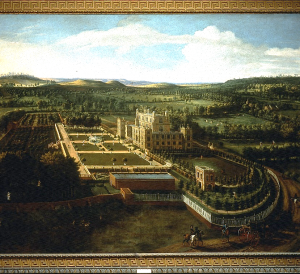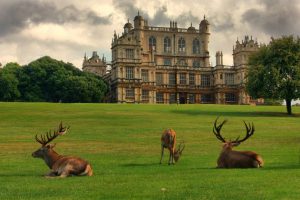May 3, 2018, by Matt Davies
Inspiring Slides: Jan Siberechts’ Wollaton Hall and Park by Ariane Watson.
This week’s blogger is second year Ancient History student Ariane Watson who was inspired by a slide in the collection that brought back childhood memories and has relevance to all of us working and studying in close proximity to one of Nottinghamshire’s finest buildings and most beautiful parks!
Growing up in Nottingham my childhood was founded on trips to Wollaton Hall and Park. I learnt how to ride a bike around its lake which according to my older siblings was filled not only with sharks but also crocodiles! I was swayed by the rhythmic motions of its steam locomotives (housed in the Industrial museum, tucked away in Wollaton’s courtyard) whilst trying my hand at Morse code and marveling at the looming textile machines. I met Nottingham’s own local legend, George the Gorilla (who I have recently learnt has his own twitter account) and met with wildlife both outside and inside the Hall. After many such visits to Wollaton Hall it is not surprising that I instantly recognised the painting of Wollaton and its grounds which still adorns one of the Hall’s many walls when I discovered it in the Digital Humanities Centre’s slide collection.
The artist was Jan Siberechts, a 17th century Flemish painter, who was born in Antwerp, the son of a sculptor. Siberechts immigrated to Britain after being invited by George Villiers, 2nd Duke of Buckingham who came upon Siberechts’ landscape works when visiting the Netherlands in 1670.
Siberechts’ popularity grew in England through his paintings of stately homes with the art historian E. Waterhouse dubbing him the ‘father of British landscape.’ His manipulations of the landscape were characterised by imagined aerial views which captured the grandeur of aristocratic houses whilst incorporating the richness of the rural surroundings.
In 1667 Siberechts was commissioned to paint Nottingham’s own Wollaton Hall, a striking innovation of Elizabethan architecture. First built during 1580 – 1588 by Sir Francis Willoughby, it was later renovated by his great-great-grandchildren Sir Thomas and Cassandra Willoughby who commissioned Siberechts’ painting. Functioning not only to immortalise Willoughby’s ancestral home it also has the practical purpose of highlighting the new formal gardens and other changes attributed to Sir Thomas and Cassandra.
Beyond the Hall stretches a tapestry of patchwork fields, a canvas which evokes country idylls and rural harmony. Siberechts’ use of deep, full colours for the acres of countryside conveys a warmth and tranquility with rolling hills stretching beyond the horizon creating a sense of seamless and effortless beauty as well as a timelessness. This creates a sense of place for the Hall as both a physical landmark, an impressive building of architectural merit, and for the family which inhabits it, their status and place within society.
Siberechts’ painting currently hangs in Wollaton Hall which after ceasing to be home to the Willoughby’s has since been home to an assortment of animals in its reincarnation as a natural history museum in 1926. More recently it became home to Batman no less, when it was used as Wayne Manor in the 2011 movie The Dark Knight Rises.
Today, Wollaton Hall is open to the public and the Siberechts’ painting hangs with pride of place amidst wax incarnations of the Willoughby family. Whilst no longer the seat of the aristocratic dynasty, the Hall and park remain a place where wildlife thrives with deer roaming the park and birds nesting in the trees -as well as in its rooms! The painting is a visual reminder of, not only the Halls’ illustrious past, but also that of Britain itself whose physical and artistic landscape was shaped by the landed gentry which once dominated the country. It is also a source of nostalgia for many locals like myself who spend happy hours roaming both the Hall and its grounds.
If you are a member of UoN’s Arts Faculty and would like to enter the Inspiring Slides competition, get your work posted here on Digital Dialogues and maybe even win a prize. Just choose a slide from the collection–any slide will do –and write a response to it. It may be a memory prompted by the slide or an immediate response in the form of a story, poem or even art work, or perhaps an examination or interpretation of the image. Prose need not be long, three or four paragraphs, 500 words is about average.
If you cannot think of a particular image but fancy having a go, there is a selection of slides chosen exclusively by the DHC team on Lightbox one in the DHC. Choose an image, scan (yes we do have a slide scanner in DHC!) or take it away and let your imagination run wild!
Send all entrees to digitalhumanities@nottingham.ac.uk
No comments yet, fill out a comment to be the first



Leave a Reply